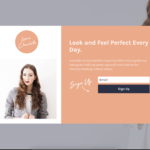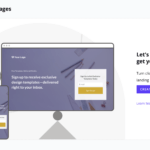Dos for Landing Page Design
Keep it Simple and Clean
When it comes to designing a landing page for lead generation, simplicity is key. A cluttered and confusing page can quickly turn off potential leads and cause them to leave without taking any action. Keep the design clean and minimalistic, with a clear and concise message that highlights the benefits of your product or service. Use a simple color scheme and avoid using too many fonts or graphics that can distract from the main message. Remember, the goal of the landing page is to capture leads, so make sure the design is focused on achieving that objective.
Make it Mobile-Friendly
In today’s world, mobile devices are becoming increasingly popular for browsing the internet. Therefore, it is crucial to ensure that your landing page is mobile-friendly. A mobile-friendly landing page is one that is easy to navigate on a smaller screen and loads quickly. To make your landing page mobile-friendly, you should use a responsive design that adjusts to the size of the screen. You should also avoid using large images or videos that take a long time to load on a mobile device. By making your landing page mobile-friendly, you can ensure that you are reaching a wider audience and increasing your chances of generating leads.
Use High-Quality Images
Using high-quality images on your landing page can significantly impact the success of your lead generation efforts. Images that are visually appealing and relevant to your product or service can grab the attention of your audience and keep them engaged. However, it’s important to ensure that the images you use are optimized for web use and don’t slow down your page’s loading time. Additionally, avoid using stock photos that are overused or generic, as they can make your page appear unoriginal and untrustworthy. Instead, consider using original images that showcase your brand’s personality and unique selling points. By using high-quality images strategically, you can enhance the overall user experience and increase the likelihood of converting visitors into leads.
Don’ts for Landing Page Design
Don’t Overcrowd the Page
When it comes to designing a landing page for lead generation, it’s important to remember that less is often more. Don’t overcrowd the page with too much information or too many elements. This can overwhelm visitors and make it difficult for them to focus on the main message or call-to-action. Instead, aim for a clean and simple design that highlights the most important information and makes it easy for visitors to take the desired action. Use white space strategically to create a sense of balance and guide the eye towards the key elements of the page. By avoiding overcrowding, you can create a more effective and engaging landing page that drives conversions and generates leads.
Avoid Using Too Many Colors
When it comes to landing page design, it’s important to keep things simple and avoid overwhelming your visitors with too many colors. Stick to a color scheme that complements your brand and use it consistently throughout your page. Using too many colors can be distracting and make it difficult for visitors to focus on the most important elements of your page, such as your call-to-action. Instead, use color strategically to draw attention to key areas and create a cohesive, visually appealing design. Remember, less is often more when it comes to landing page design.
Don’t Use Too Much Text
When it comes to designing a landing page for lead generation, it’s important to remember that less is often more. While it can be tempting to include as much information as possible about your product or service, overwhelming your visitors with too much text can actually be counterproductive. Instead, focus on using concise, clear language that gets straight to the point. Use bullet points and subheadings to break up large blocks of text and make it easier for visitors to scan your page. Remember, the goal of your landing page is to capture leads, not to provide an exhaustive explanation of your offering. Keep it simple and to the point, and you’ll be more likely to see success.
Dos for Lead Generation
Use Clear and Compelling Headlines
The headline is the first thing that visitors see when they land on your page, so it’s crucial to make it clear and compelling. Your headline should clearly communicate the value proposition of your offer and entice visitors to learn more. Use action-oriented language and make sure your headline is relevant to the content on the page. Avoid using vague or generic headlines that don’t provide any context or value. A strong headline can make all the difference in capturing the attention of your target audience and driving conversions.
Include a Strong Call-to-Action
Including a strong call-to-action (CTA) is crucial for lead generation on landing pages. Your CTA should be clear, concise, and prominently displayed on the page. Use action-oriented language that encourages visitors to take the desired action, such as “Download Now” or “Sign Up Today.” It’s also important to make sure your CTA stands out visually, using contrasting colors or bold text. However, be careful not to overwhelm visitors with too many CTAs or confusing messaging. Stick to one clear and compelling CTA that aligns with your overall marketing goals.
Offer Value to Your Visitors
One of the most important things to keep in mind when designing a landing page for lead generation is to offer value to your visitors. This means providing them with something that they find useful or valuable in exchange for their contact information. This could be anything from a free e-book or whitepaper to a free trial of your product or service. Whatever it is, make sure it’s something that your target audience will find valuable and relevant to their needs. By offering value, you’ll not only increase the chances of visitors converting into leads, but you’ll also build trust and credibility with your audience.
Don’ts for Lead Generation
Don’t Ask for Too Much Information
When designing a landing page for lead generation, it’s important to strike a balance between gathering enough information to qualify leads and not overwhelming them with too many form fields. Asking for too much information can be a major turnoff for potential leads, causing them to abandon the form altogether. Instead, focus on collecting only the most essential information, such as name and email address, and consider offering incentives or additional content in exchange for more detailed information. By keeping your form simple and straightforward, you’ll increase the likelihood of capturing valuable leads and ultimately driving conversions.
Avoid Using Generic Copy
When it comes to creating effective landing pages for lead generation, using generic copy can be a major pitfall. Your copy should be tailored to your specific audience and speak directly to their pain points and needs. Avoid using vague or overused phrases that don’t provide any real value or insight. Instead, focus on crafting copy that is clear, concise, and compelling. Use language that resonates with your target audience and highlights the unique benefits of your product or service. By avoiding generic copy, you can create landing pages that truly engage and convert your visitors.
Don’t Use Misleading Language
When creating a landing page for lead generation, it’s important to avoid using misleading language. This includes making promises that you can’t keep or using clickbait-style headlines that don’t accurately represent the content on the page. Misleading language can damage your credibility and lead to a high bounce rate, as visitors quickly realize that your page isn’t what they were expecting. Instead, focus on using clear and concise language that accurately represents your offer and provides value to your audience. This will help you build trust with your visitors and increase the likelihood of converting them into leads.
Dos for Form Design
Keep the Form Short and Simple
When it comes to lead generation, the form on your landing page is crucial. It’s important to keep the form short and simple, as lengthy forms can deter potential leads from filling them out. Only ask for the information that is absolutely necessary, such as name and email address. Additionally, make sure the form is easy to navigate and visually appealing. A cluttered or confusing form can also turn potential leads away. By keeping the form short and simple, you increase the likelihood of capturing valuable leads for your business.
Use Clear and Simple Labels
Using clear and simple labels is crucial for effective lead generation on landing pages. Visitors should be able to quickly understand what they are signing up for and what information they need to provide. Avoid using jargon or technical terms that may confuse or intimidate potential leads. Instead, use straightforward language that clearly communicates the value proposition of your offer. Additionally, make sure that the labels are visually prominent and easy to read. This will help to ensure that visitors are more likely to engage with your landing page and ultimately convert into leads.
Include Social Proof
Including social proof on your landing page can be a powerful tool for lead generation. Social proof can come in many forms, such as customer testimonials, reviews, or social media shares. By showcasing positive feedback from satisfied customers, you can build trust and credibility with potential leads. However, it’s important to ensure that the social proof you include is relevant and authentic. Avoid using generic or fake testimonials, as this can actually harm your credibility. Instead, focus on gathering genuine feedback from happy customers and using it to showcase the value of your product or service.
Don’ts for Form Design
Don’t Ask for Unnecessary Information
When designing a landing page for lead generation, it’s important to keep in mind that visitors are often short on time and patience. Asking for unnecessary information can be a major turn-off and may cause potential leads to abandon the page altogether. Stick to asking for only the most essential information, such as name and email address. Avoid asking for personal details that aren’t relevant to your business or that could make visitors uncomfortable. Remember, the goal is to make the lead generation process as easy and seamless as possible for your visitors.
Avoid Using Confusing Labels
When designing a landing page for lead generation, it’s important to avoid using confusing labels. This can be a major turn-off for potential leads, as they may not understand what you’re offering or how to proceed. To avoid confusion, make sure your labels are clear and concise. Use simple language that is easy to understand, and avoid using industry jargon or technical terms that may be unfamiliar to your audience. Additionally, make sure your labels are consistent throughout your landing page, so that visitors can easily navigate and understand your content. By avoiding confusing labels, you can create a more user-friendly landing page that is more likely to generate leads and conversions.
Don’t Use Captchas
Don’t Use Captchas: Captchas are often used to prevent spam and bots from filling out forms on landing pages. However, they can be frustrating for users and may even deter them from completing the form altogether. Instead of using captchas, consider implementing other security measures such as email verification or using a double opt-in process. This will ensure that your leads are genuine while also providing a better user experience.
Next Steps: Now that you have a better understanding of the dos and don’ts of landing page design for lead generation, it’s time to put your knowledge into action. If you’re looking for a team of experts to help you create high-converting landing pages, look no further than Nonstop Development. Our experienced designers and developers can help you create landing pages that not only look great but also drive results. Contact us today at https://www.nonstopdev.com to learn more about our services and how we can help you take your lead generation efforts to the next level.











